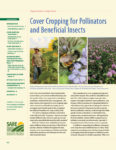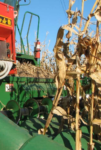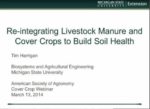Showing 41-50 of 78 results
Cover Crops as Part of an Overall Nutrient Management System
In this session, Steven Mirsky (USDA-ARS) and Heather Darby (University of Vermont) discuss the role of cover crops in integrated fertility management and address cover crops in the context of forages, dairies, perennials and pastures, and rotating pasture to grain.

Cover Cropping for Pollinators and Beneficial Insects
This 16-page bulletin will help you use cover crops to encourage populations of pollinators and beneficial insects on your farm while you address your other resource concerns.

Cover Crops for Sustainable Crop Rotations
Cover crops are one of the best ways to improve soil health, reduce off-farm inputs and protect natural resources. Find a wealth of educational materials developed out of decades of SARE-funded cover crop research.

Berry Soil and Nutrient Management Guide for Educators and Growers
This manual has been designed as a comprehensive guide for educators and commercial berry growers interested in improving berry crop soil and nutrient management.

Broadcast of Opening Sessions
Watch opening sessions of the conference, held on Tuesday, Feb. 18 and broadcasted live to 230 locations across the country as part of the Cover Crops and Soil Health Forums.

Grazing Cover Crops and Benefits for Livestock Operations
This session explored integrating cover crops with livestock operations.

Environmental Impacts of Cover Crops
Speakers in this session discussed both local and off-site environmental impacts of using cover crops.

Integrating No-Till or Strip-Till with Cover Crops
Maximize soil conservation and soil health benefits of cover crops by combining this practice with no-till or strip-till systems.

Cover Crops, Soil Health Principles and Maximizing Yields
Learn about basic soil health principles and how cover crops are key to making those happen on your farm.

Combining Livestock, Manure and Cover Crops
A livestock and cover crop combination is the fastest way to profit from your investment.